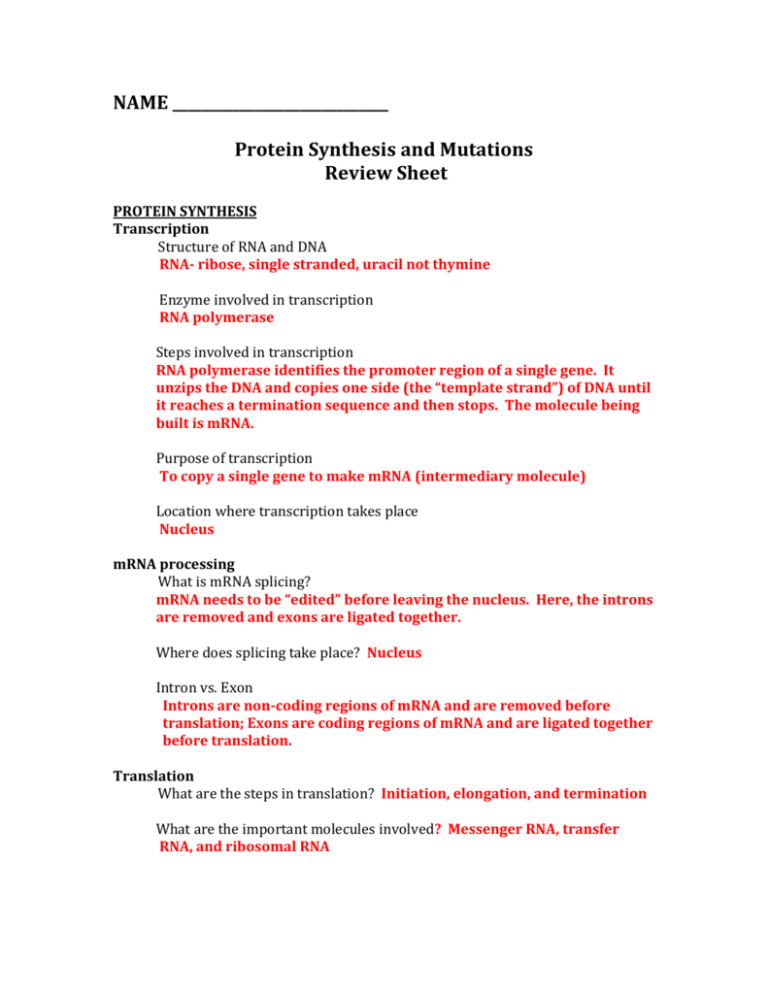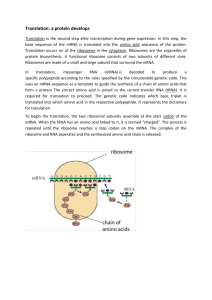Chapter 13 Review Sheet
advertisement

NAME _____________________________ Protein Synthesis and Mutations Review Sheet PROTEIN SYNTHESIS Transcription Structure of RNA and DNA RNA- ribose, single stranded, uracil not thymine Enzyme involved in transcription RNA polymerase Steps involved in transcription RNA polymerase identifies the promoter region of a single gene. It unzips the DNA and copies one side (the “template strand”) of DNA until it reaches a termination sequence and then stops. The molecule being built is mRNA. Purpose of transcription To copy a single gene to make mRNA (intermediary molecule) Location where transcription takes place Nucleus mRNA processing What is mRNA splicing? mRNA needs to be “edited” before leaving the nucleus. Here, the introns are removed and exons are ligated together. Where does splicing take place? Nucleus Intron vs. Exon Introns are non-coding regions of mRNA and are removed before translation; Exons are coding regions of mRNA and are ligated together before translation. Translation What are the steps in translation? Initiation, elongation, and termination What are the important molecules involved? Messenger RNA, transfer RNA, and ribosomal RNA What are the three major types of RNA (mRNA, tRNA and rRNA) and their functions mRNA- copies a gene from DNA and carries the message over to the ribosome to be translated. Codons. tRNA- carries the amino acid on one side and an anti-codon on the other. If the anti-codon of tRNA complements the mRNA codon, the amino acid will be added to the chain. rRNA- com ponent of the ribosome, like the “workbench” for translation How does the appropriate amino acid get added? The tRNA anticodon must match/complement the mRNA codon. What is an anti-codon, codon? Anti-codon is a triplet of tRNA nucleotides and the codon is a triplet of mRNA nucleotides Where are they located and how are they related? See above What is the significance of translation? It is how mRNA gets interpreted into a chain of amino acids Be able to use the Genetic Code Chart Mutations Chromosomal mutations (for examples see notes) Duplication Deletion Inversion Translocation Types of sequence (nucleotide) mutations and there possible outcomes Substitution: 1 base pair changes, like GCC GCA Deletion: 1 base pair is removed, causing the reading frame to move down one base, changing the amino acids Insertion: an additional base pair is added, this will move the reading frame over by 1, changing the amino acids What causes these mutations? Frame shifts (insertions and deletions), point mutations (any change in a single nucleotide of DNA sequence) When would mutations affect offspring of the parent? Only if the mutations occur in the REPRODUCTIVE cells (aka “germ line”). Fertilization takes place, and now every cell in the new baby will contain the mutation. When would mutations not affect the offspring? When they occur in the body cells (aka “somatic cells”) of the individual. For example, skin cancer caused by sun exposure over a person’s lifetime can NOT be passed on to their offspring. Examples of each type of mutation (substitution, insertion, deletion) Be able to make an example of these, like the work sheet on mutations we did in class Substitutions can have a no effect on a protein—how is that possible? If the substitution changes one codon to a different codon for the SAME AMINO ACID Mutagens Agents that cause changes in DNA/mutations Ex: Benzene, dioxins, formaldehyde, UV light exposure, radiation You should be able to write the complementary strands of DNA and RNA Be able to use the genetic code table to determine an amino acid sequence Remember you are to use this as a GUIDE to the main topics that may be included on the test. You should also review your notes, the textbook, activities, websites and videos that have been done during this topic for more specific details.









